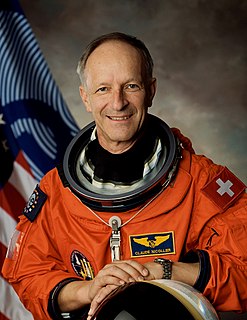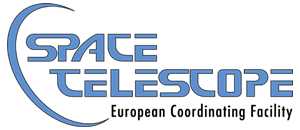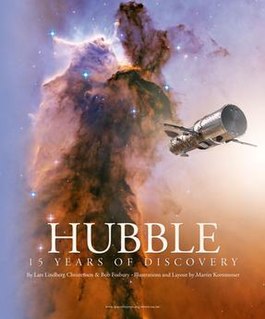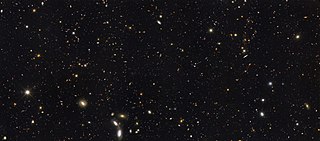External links
- About Martin Kornmesser
- The European Homepage for the NASA/ESA Hubble Space Telescope
- European Space Agency
- Space Telescope European Coordinating Facility
Martin Kornmesser is a graphic designer working at the ESA/NASA Hubble European Space Agency Information Centre (HEIC) in Munich/Garching. He obtained his degree in graphics design in Munich in 1989. Kornmesser has actively pioneered the exploration of the world of computer graphics. In 1990 he was the co-founder of the company ART-M, where he created illustrations, wall-paintings and all kinds of graphics design before joining ESA's Hubble outreach group in 1999.

The Hubble Space Telescope is a space telescope that was launched into low Earth orbit in 1990 and remains in operation. It was not the first space telescope, but it is one of the largest and most versatile, renowned both as a vital research tool and as a public relations boon for astronomy. The Hubble telescope is named after astronomer Edwin Hubble and is one of NASA's Great Observatories. The Space Telescope Science Institute (STScI) selects Hubble's targets and processes the resulting data, while the Goddard Space Flight Center (GSFC) controls the spacecraft.

The James Webb Space Telescope (JWST) is a space telescope designed primarily to conduct infrared astronomy. The most powerful telescope ever launched into space, its greatly improved infrared resolution and sensitivity will allow it to view objects too old, distant, and faint for the Hubble Space Telescope. This is expected to enable a broad range of investigations across the fields of astronomy and cosmology, such as observations of first stars and the formation of the first galaxies, and detailed atmospheric characterization of potentially habitable exoplanets. JWST was launched on 25 December 2021 on an ESA Ariane 5 rocket from Kourou, French Guiana, and as of April 2022 is undergoing testing and alignment. Once operational, expected in May 2022, JWST is intended to succeed the Hubble as NASA's flagship mission in astrophysics.

Jean-François André Clervoy is a French engineer and a CNES and ESA astronaut. He is a veteran of three NASA Space Shuttle missions.

Claude Nicollier is the first astronaut from Switzerland. He has flown on four Space Shuttle missions. His first spaceflight (STS-46) was in 1992, and his final spaceflight (STS-103) was in 1999. He took part in two servicing missions to the Hubble Space Telescope. During his final spaceflight he participated in a spacewalk, becoming the first European Space Agency astronaut to do so during a Space Shuttle mission. In 2000 he was assigned to the Astronaut Office Extravehicular Activity Branch, while maintaining a position as Lead ESA Astronaut in Houston. Nicollier retired from ESA in April 2007.

NASA's series of Great Observatories satellites are four large, powerful space-based astronomical telescopes launched between 1990 and 2003. They were built with different technology to examine specific wavelength/energy regions of the electromagnetic spectrum: gamma rays, X-rays, visible and ultraviolet light, and infrared light.

The European Space Astronomy Centre (ESAC) near Madrid in Spain is the ESA's centre for space science. It hosts the science operation centres for all ESA astronomy and planetary missions together with their scientific archives. Past and present missions represented at ESAC include Akari, BepiColombo, Cassini–Huygens, Cluster, Exomars, Gaia, Herschel, Hubble, ISO, INTEGRAL, IUE, LISA Pathfinder, Mars Express, Planck, Rosetta, SOHO, Solar Orbiter, Venus Express, and XMM-Newton.

The Space Telescope – European Coordinating Facility (ST-ECF) was an institution which provided a number of support and service functions primarily for European observers of the NASA/ESA Hubble Space Telescope (HST). It was established in 1984 by the European Space Agency (ESA) and the European Southern Observatory (ESO), and was located at the ESO headquarters in Garching bei München, Germany. The ST-ECF ceased operations on 31 December 2010.
The Hubble Heritage Project was founded in 1998 by Keith Noll, Howard Bond, Forrest Hamilton, Anne Kinney, and Zoltan Levay at the Space Telescope Science Institute. The team released, on an almost monthly basis, pictures of celestial objects like planets, stars, galaxies and galaxy clusters.

The ESA/ESO/NASA FITS Liberator is a free software program for processing and editing astronomical science data in the FITS format to reproduce images of the universe. Version 3 and later are standalone programs; earlier versions were plugins for Adobe Photoshop. FITS Liberator is free software released under the BSD-3 license. The engine behind the FITS Liberator is NASA's CFITSIO library.
The Hubble European Space Agency Information Centre (HEIC) is a science communication office, established at the Space Telescope - European Coordinating Facility (ST-ECF) in Munich, Germany late in 1999. This initiative was taken so as to fulfil the NASA/ESA Hubble Space Telescope (HST) outreach and education tasks for the European Space Agency (ESA), as outlined in an agreement between NASA and ESA.
Robert (Bob) Fosbury is currently an emeritus astronomer at the European Southern Observatory and an honorary professor at the Institute of Ophthalmology at UCL. He is an astronomer who worked for 26 years at the European Space Agency (ESA) as part of ESA's collaboration with NASA on the Hubble Space Telescope (HST) project at ST-ECF. Based at the European Southern Observatory (ESO) near Munich in Germany, Fosbury joined this initiative in 1985, more than 5 years before launch. During the latter part of this period, Bob served on NASA's Ad Hoc Science Working Group and ESA's Study Science Team as they developed the instrument concepts for the James Webb Space Telescope, the next-generation space observatory.

Hubble – 15 Years of Discovery (ISBN 0-387-28599-7) is a book that formed part of the European Space Agency's 15th anniversary celebration activities for the 1990 launch of the NASA/ESA Hubble Space Telescope. Its main emphasis is on the exquisite Hubble images that have enabled astronomers to gain entirely new insights into the workings of a huge range of different astronomical objects. Hubble has provided the visual overview of the underlying astrophysical processes taking place in these objects, ranging from planets in the Solar System to galaxies in the young Universe. This book shows the close relationship between the results of great scientific value and of eye-catching beauty and artistic potential.

NGC 3242 is a planetary nebula located in the constellation Hydra.

The Great Observatories Origins Deep Survey, or GOODS, is an astronomical survey combining deep observations from three of NASA's Great Observatories: the Hubble Space Telescope, the Spitzer Space Telescope, and the Chandra X-ray Observatory, along with data from other space-based telescopes, such as XMM Newton, and some of the world's most powerful ground-based telescopes.

The Swiss Space Office (SSO) is the federal government's competence centre for national and international space matters. In its role it cooperates closely with other federal offices and is responsible for the preparation and implementation of the policy and strategic orientations of the space domain in Switzerland. The SSO is part of the State Secretariat for Education, Research, and Innovation. The Head of the SSO is Dr. Renato Krpoun.

Euclid is a visible to near-infrared space telescope currently under development by the European Space Agency (ESA) and the Euclid Consortium. The objective of the Euclid mission is to better understand dark energy and dark matter by accurately measuring the acceleration of the universe. To achieve this, the Korsch-type telescope will measure the shapes of galaxies at varying distances from Earth and investigate the relationship between distance and redshift. Dark energy is generally accepted as contributing to the increased acceleration of the expanding universe, so understanding this relationship will help to refine how physicists and astrophysicists understand it. Euclid's mission advances and complements ESA's Planck telescope. The mission is named after the ancient Greek mathematician Euclid of Alexandria.

The Nancy Grace Roman Space Telescope is a NASA infrared space telescope currently in development and scheduled to launch no later than May 2027. Roman was recommended in 2010 by the United States National Research Council Decadal Survey committee as the top priority for the next decade of astronomy. On 17 February 2016, WFIRST was approved for development and launch.

The 2012 National Reconnaissance Office space telescope donation to NASA was the declassification and donation to NASA of two identical space telescopes by the United States National Reconnaissance Office. The donation has been described by scientists as a substantial improvement over NASA's current Hubble Space Telescope. Although the telescopes themselves were given to NASA at no cost, the space agency must still pay for the cost of instruments and electronics for the telescopes, as well as the launch of the telescopes. On February 17, 2016, the Nancy Grace Roman Space Telescope was formally designated as a mission by NASA, predicated on using one of the space telescopes.

The James Webb Space Telescope (JWST) is an international 21st-century space observatory that was launched on 25 December 2021. It is intended to be the premier observatory of the 2020s, combining the largest mirror yet on a near-infrared space telescope with a suite of technologically advanced instruments from around the world.